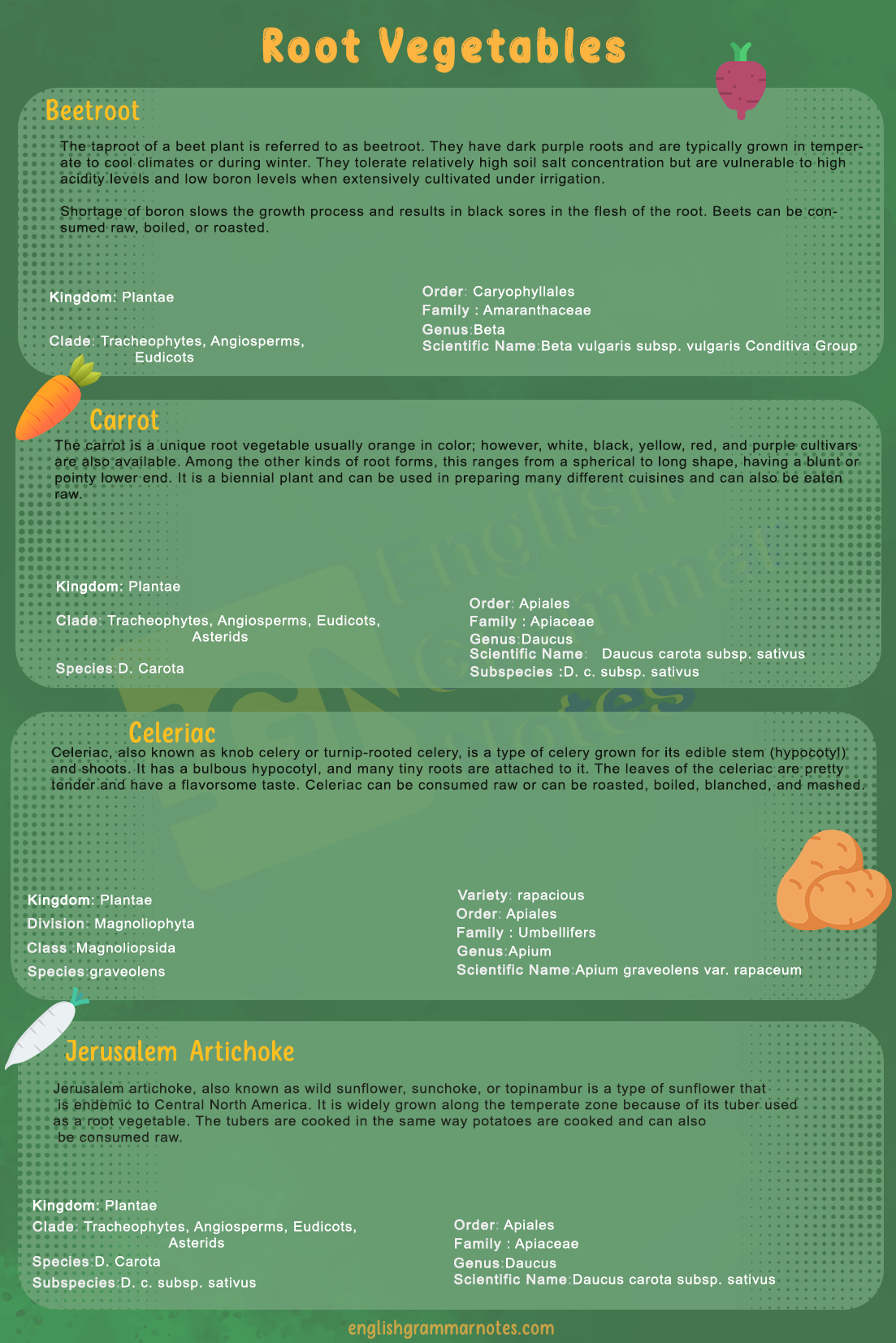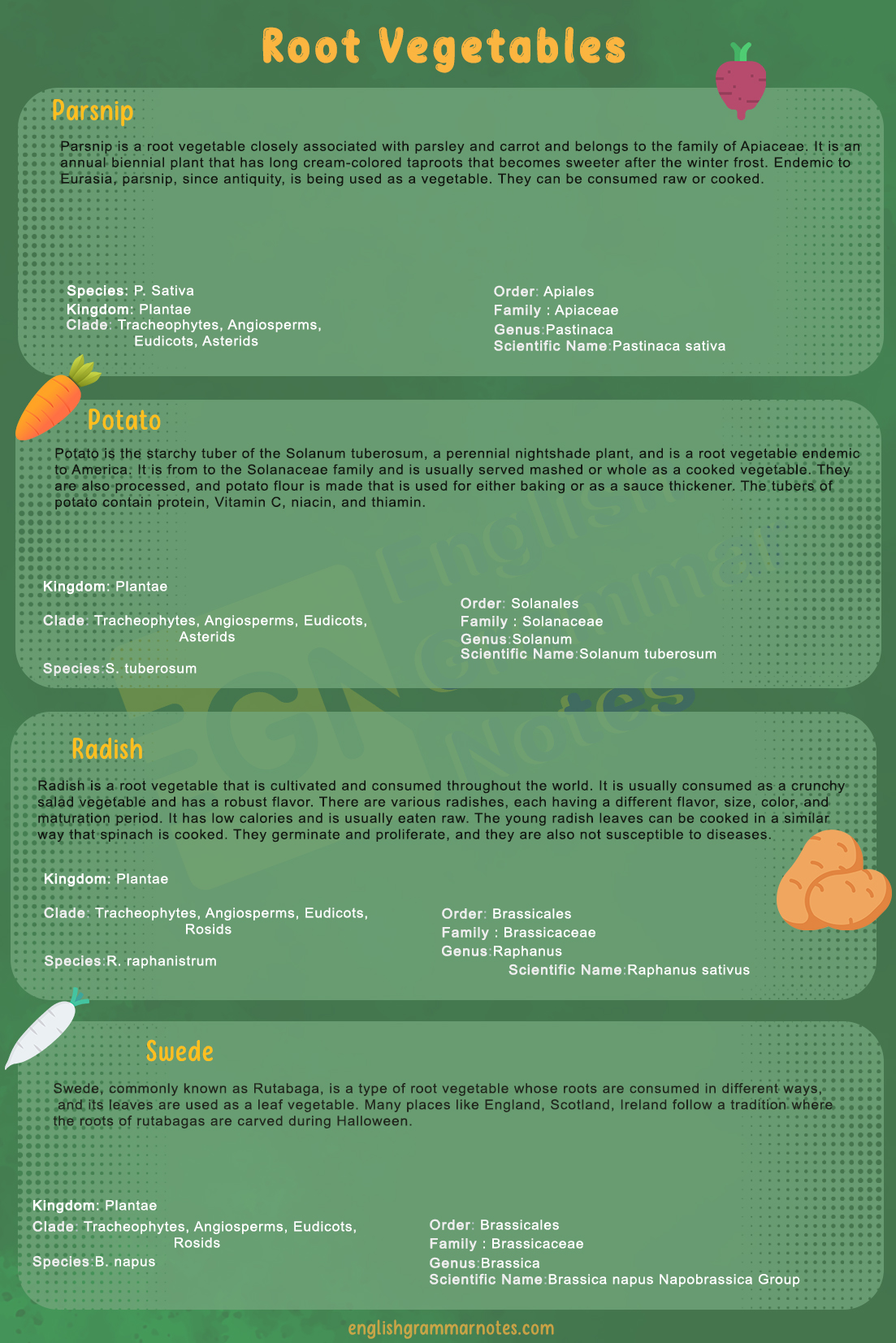Root Vegetables: Root vegetables refer to the underground parts of plants that humans consume. They acquire nutrients from underground and develop strong roots and skin not to get destroyed while growing. These vegetables require great care, adequate space and usually store energy in the form of carbohydrates.
There are many root vegetable names, and each of them can be cooked in various ways. We have prepared a list of root vegetables and their scientific classification so that you can easily remember which vegetables are known as root vegetables. This list of root vegetables with pictures will help you to easily identify the vegetables as well.
Study the most important English Vocabulary Words identified by our experts and learn the right vocabulary to use in your day to day conversations
List of Root Vegetables
Name of Root Vegetables
Description of root vegetables given on the list
Beetroot
The taproot of a beet plant is referred to as beetroot. They have dark purple roots and are typically grown in temperate to cool climates or during winter. They tolerate relatively high soil salt concentration but are vulnerable to high acidity levels and low boron levels when extensively cultivated under irrigation.
Shortage of boron slows the growth process and results in black sores in the flesh of the root. Beets can be consumed raw, boiled, or roasted.
| Kingdom | Plantae |
| Clade | Tracheophytes, Angiosperms, Eudicots |
| Order | Caryophyllales |
| Family | Amaranthaceae |
| Genus | Beta |
| Scientific name | Beta vulgaris subsp. vulgaris Conditiva Group |
Carrot
The carrot is a unique root vegetable usually orange in color; however, white, black, yellow, red, and purple cultivars are also available. Among the other kinds of root forms, this ranges from a spherical to long shape, having a blunt or pointy lower end. It is a biennial plant and can be used in preparing many different cuisines and can also be eaten raw.
| Kingdom | Plantae |
| Clade | Tracheophytes, Angiosperms, Eudicots, Asterids |
| Order | Apiales |
| Family | Apiaceae |
| Genus | Daucus |
| Species | D. Carota |
| Subspecies | D. c. subsp. sativus |
| Scientific name | Daucus carota subsp. sativus |
Celeriac
Celeriac, also known as knob celery or turnip-rooted celery, is a type of celery grown for its edible stem (hypocotyl) and shoots. It has a bulbous hypocotyl, and many tiny roots are attached to it. The leaves of the celeriac are pretty tender and have a flavorsome taste. Celeriac can be consumed raw or can be roasted, boiled, blanched, and mashed.
| Kingdom | Plantae |
| Division | Magnoliophyta |
| Class | Magnoliopsida |
| Order | Apiales |
| Family | Umbellifers |
| Genus | Apium |
| Species | graveolens |
| Variety | rapacious |
| Scientific name | Apium graveolens var. rapaceum |
Jerusalem Artichoke
Jerusalem artichoke, also known as wild sunflower, sunchoke, or topinambur is a type of sunflower that is endemic to Central North America. It is widely grown along the temperate zone because of its tuber used as a root vegetable. The tubers are cooked in the same way potatoes are cooked and can also be consumed raw.
| Kingdom | Plantae |
| Clade | Tracheophytes, Angiosperms, Eudicots, Asterids |
| Order | Asterales |
| Family | Asteraceae |
| Genus | Helianthus |
| Species | H. tuberous |
| Scientific name | Helianthus tuberosus |

Parsnip
Parsnip is a root vegetable closely associated with parsley and carrot and belongs to the family of Apiaceae. It is an annual biennial plant that has long cream-colored taproots that becomes sweeter after the winter frost. Endemic to Eurasia, parsnip, since antiquity, is being used as a vegetable. They can be consumed raw or cooked.
| Kingdom | Plantae |
| Clade | Tracheophytes, Angiosperms, Eudicots, Asterids |
| Order | Apiales |
| Family | Apiaceae |
| Genus | Pastinaca |
| Species | P. Sativa |
| Scientific name | Pastinaca sativa |
Potato
Potato is the starchy tuber of the Solanum tuberosum, a perennial nightshade plant, and is a root vegetable endemic to America. It is from to the Solanaceae family and is usually served mashed or whole as a cooked vegetable. They are also processed, and potato flour is made that is used for either baking or as a sauce thickener. The tubers of potato contain protein, Vitamin C, niacin, and thiamin.
| Kingdom | Plantae |
| Clade | Tracheophytes, Angiosperms, Eudicots, Asterids |
| Order | Solanales |
| Family | Solanaceae |
| Genus | Solanum |
| Species | S. tuberosum |
| Scientific name | Solanum tuberosum |
Radish
Radish is a root vegetable that is cultivated and consumed throughout the world. It is usually consumed as a crunchy salad vegetable and has a robust flavor. There are various radishes, each having a different flavor, size, color, and maturation period. It has low calories and is usually eaten raw. The young radish leaves can be cooked in a similar way that spinach is cooked. They germinate and proliferate, and they are also not susceptible to diseases.
| Kingdom | Plantae |
| Clade | Tracheophytes, Angiosperms, Eudicots, Rosids |
| Order | Brassicales |
| Family | Brassicaceae |
| Genus | Raphanus |
| Species | R. raphanistrum |
| Scientific name | Raphanus sativus |
Swede
Swede, commonly known as Rutabaga, is a type of root vegetable whose roots are consumed in different ways, and its leaves are used as a leaf vegetable. Many places like England, Scotland, Ireland follow a tradition where the roots of rutabagas are carved during Halloween.
| Kingdom | Plantae |
| Clade | Tracheophytes, Angiosperms, Eudicots, Rosids |
| Order | Brassicales |
| Family | Brassicaceae |
| Genus | Brassica |
| Species | B. napus |
| Scientific name | Brassica napus Napobrassica Group |

Sweet Potato
The sweet potato is a dicot plant that belongs to the family of Convolvulaceae. The young leaves and shoots of this plant are often consumed as greens, and the fleshy roots are cooked as vegetables. The crop is produced in Japan for drying and also for the production of alcohol and starch.
| Kingdom | Plantae |
| Clade | Tracheophytes, Angiosperms, Eudicots, Asterids |
| Order | Solanales |
| Family | Convolvulaceae |
| Genus | Ipomoea |
| Species | I. batatas |
| Scientific name | Ipomoea batatas |
Turnip
The turnip often referred to as the white turnip, is a type of root vegetable produced or cultivated worldwide in temperate climates for its white and meaty taproot. The young turnip roots are consumed either raw or pickled, whereas the young leaves can be cooked and then served. Either whole or mashed, the seeds are commonly used in stews.
| Kingdom | Plantae |
| Clade | Tracheophytes, Angiosperms, Eudicots, Rosids |
| Order | Brassicales |
| Family | Brassicaceae |
| Genus | Brassica |
| Species | B. Rapa |
| Scientific name | Brassica rapa subsp. Rapa |